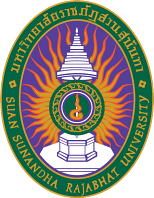Development of Bedroom Decoration Designs from Processed Reed Mats Using Embroidery Techniques Mudmee Weaving and Processed Reed Mat Group, Huai Kaeo Subdistrict, Phichit Province
Keywords:
Bedroom decoration design, Mudmee weaving and processed reed mat group, Embroidery techniques, Product prototypesAbstract
Abstract
The objective of this research was to design and develop bedroom decoration items from processed reed mats using embroidery techniques for the Mudmee Weaving and Processed Reed Mat Group in Huai Kaeo Subdistrict, Phichit Province. The bedroom decoration was designed using processed reed mats with embroidery techniques, featuring simple shapes. The design incorporates other materials to create variety in both style and functionality. The bedroom decorations include a table lamp, a wooden lamp, rectangular throw pillows, square throw pillows, a bedside table mat, a doormat, and a bedside storage box, with three variations for each product. Five experts were asked to select the most appropriate design. Prototypes of the products were then created and evaluated by a sample group of 100 general individuals. The data collected was analyzed using frequency, mean, and percentage, and the results were presented in tabular form to support the discussion.
The research findings revealed that the inspiration for designing the bedroom decorations used materials suitable for embroidery, including sequins, beads, pearls, and floral patterns. The color tones chosen were purple, pink, and white. The satisfaction of the sample group towards the bedroom decoration design was at a high level (𝑥̅ = 4.19). When analyzed by individual aspects, creativity was rated highly (𝑥̅ = 4.23). The overall bedroom decoration products were also rated highly (𝑥̅ = 4.15). When considering individual items, the beauty of the products, which could enhance the value of the goods, was rated highly (𝑥̅ = 4.24). Regarding functionality, the products were rated highly (𝑥̅ = 4.20). Furthermore, when considering whether the products were suitable for sale, the products were rated highly (𝑥̅ = 4.31).
References
Chalisaraphong, R., Thomrongsinthaworn, S., Chanphet, P., & Somboonsuniti, P. (2023). The Study of Buying Behavior and Market Conditions of Handicrafts, Wicker Furniture and Home Decorations. Journal for Strategy and Enterprise Competitiveness, 2(6), 49-62. Retrieved from https://so07.tci-thaijo.org/index.php/STECOJournal/article/view/3786 (In Thai)
Hongrattanavorakit, S., & Chantakul, S. (2022). Development of home decoration products from woven origami technique community products sewing enterprise and artificial fabric Khao Kaew Srisomboon Thung Saliam Sukhothai. Art and Architecture Journal Naresuan University, 13(1), 113-122. Retrieved from https://so01.tci-thaijo.org/index.php/ajnu/article/view/246574 (In Thai)
Hongrattanavorakit, S., Chantakul, S., & Aitsarasuchip, K. (2024). Bedroom Decor Product Development Using Woven Fabrics from Local Weaving Community Enterprises in Ban Kha District, Ratchaburi Province, Enhanced with Origami and Embroidery Techniques. Journal of Cultural Approach, 25(47), 3-15. Retrieved from https://so02.tci-thaijo.org/index.php/cultural_approach/article/view/265094 (In Thai)
Jaroonchon, T., Wongsathongdee, S., & Anunvrapong, A. (2020). Decorating of Lamp Production with Embroidery Technique to Increase the Value of Design. Ratchaphruek Journal, 18(2), 42-53. Retrieved from https://so05.tci-thaijo.org/index.php/Ratchaphruekjournal/article/view/226673 (In Thai)
Keawpan, T., Itsaranuwat, S., & Plangnok, J. (2020). Principles and concepts in product design. Journal of Humanities and Social Sciences, Surin Rajabhat University, 22(2), 161-182. Retrieved from https://so03.tci-thaijo.org/index.php/jhssrru/article/view/248733 (In Thai)
Khatasombun, H. (2022). Social Capital and Model Community Development to Create A Sustainable Community Based- Economy of Huay Kaew Sub-District, Bueng na Rang District, Phichit Province. Journal of MCU Nakhondhat, 9(10), 32-48. Retrieved from https://so03.tci-thaijo.org/index.php/JMND/article/view/264435 (In Thai)
Kongsap, R. (2022). Chairman of the community enterprise group for weaving Mudmee cloth and processed reed mats Huai Subdistrict Kaew, Bueng Narang District Phichit Province.
Oonchoung, P. (2022). Value Added Creation of Reed Mats Weaving Transforming For Community Economy. A Case Study: Ban Nongsim Prueyai Sub-district, Khukhan District, Sisaket Province. Journal of Man and Society, 7(2), 97-114. Retrieved from https://so06.tci-thaijo.org/index.php/husocjournal/article/view/246876 (In Thai)
Plengdeesakul, B., & Plengdeesakul, P. (2022). Creative Product Development from Local Wisdom in Khok Phu Tha Ka Khon Kaen Province A Case Study of Reed Mat Weaving Group Ban Hin Rong, Wiang Kao District, Khon Kaen Province. Chophayom Journal, 33(2), 15-39. Retrieved from https://so01.tci-thaijo.org/index.php/ejChophayom/article/view/260122 (In Thai)
Raitang, N., Oudjai, R., Pookan, C., & Kason, K. (2020). Cost of return and Reed Mat Development Somboondee House, Mengrai Sub-District, Phaya Mengrai District Chiang Rai. The Journal of Accounting Review Chiang Rai Rajabhat University, 5(2), 44-55. Retrieved from https://so02.tci-thaijo.org/index.php/JAR_CRRU/article/view/259870 (In Thai)

Downloads
Published
How to Cite
Issue
Section
License
Copyright (c) 2024 Institute of Research and Development, Suan Sunandha Rajabhat University

This work is licensed under a Creative Commons Attribution-NonCommercial-NoDerivatives 4.0 International License.
บทความที่ได้รับการตีพิมพ์เป็นลิขสิทธิ์ของ สถาบันวิจัยและพัฒนา มหาวิทยาลัยราชภัฎสวนสุนันทา
ข้อความที่ปรากฏในบทความแต่ละเรื่องในวารสารวิชาการเล่มนี้เป็นความคิดเห็นส่วนตัวของผู้เขียนแต่ละท่านไม่เกี่ยวข้องกับมหาวิทยาลัยราชภัฎสวนสุนันทา และคณาจารย์ท่านอื่นๆในมหาวิทยาลัยฯ แต่อย่างใด ความรับผิดชอบองค์ประกอบทั้งหมดของบทความแต่ละเรื่องเป็นของผู้เขียนแต่ละท่าน หากมีความผิดพลาดใดๆ ผู้เขียนแต่ละท่านจะรับผิดชอบบทความของตนเองแต่ผู้เดียว

 ISSN
ISSN 
